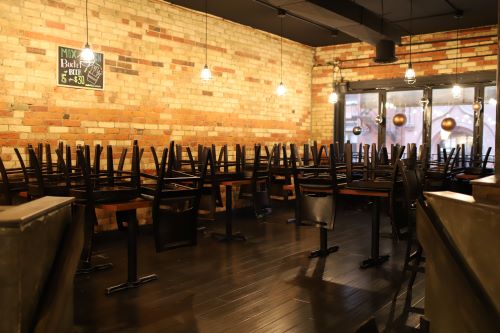Applications open Monday for federal grants to help pandemic-stricken restaurants Early SBA registration begins Friday
 by Kyle M. Taylor and Benjamin R. Bostic
by Kyle M. Taylor and Benjamin R. Bostic
It is no secret that COVID-19 and the consequent lockdowns and restrictions on indoor dining have devastated the restaurant industry.
Now, additional, tax-free federal grants are on the way under the Restaurant Revitalization Fund (RRF).
The recently passed American Rescue Plan (ARP) has $28.6 billion set aside for RRF grants. The Small Business Administration (SBA) will oversee to assist restaurants, bars, snack bars serving nonalcoholic beverages, caterers, food trucks, and street vendors.
Additionally, bakeries, brewpubs, wineries, distilleries, inns are eligible as long as on-site food and drink sales accounted for at least 33 percent of gross receipts in 2019.
- Early registration starts 9 a.m. on Friday, April 30 on sba.gov: Businesses can register for an account and review the sample application, program guide and cross-program eligibility chart. For additional information, including SBA articles about the program and a number for call center support, click here. All of these materials are available on the website now.
- Application acceptance on the site begins noon on Monday, May 3: The SBA will accept applications until funds are exhausted. Businesses owned by socially and economically disadvantaged individuals will have priority during the first 21 days (see Who can apply and what is the timing? below)
- Businesses working with Square or Toast do not need to register beforehand on the application portal. Restaurants can also work with other point-of-sale (POS) service providers partnering with the SBA. For more information, click here.
Based on SBA guidance, the following are some answers to questions about the program:
Q: How much can an applicant receive?
A: Applicants must at least request $1,000 and can get up to $5 million per location, with the total grant amount capped at $10 million.
Q: How do I calculate how much my business can receive?
A: Calculating what you can receive depends on when your business was in operation. In all cases, if your business received a Paycheck Protection Program loan, that amount of the loan is deducted from what you can receive.
- Operating on or before January 2019: Subtract the 2019 gross receipts from 2020s gross receipts, as well as any PPP loan amounts.
- In operations during part of 2019: Take the average monthly 2019 gross receipts and multiply by 12, and then subtract it from 2020s gross receipts and any PPP loans.
- Started operations sometime between January 2020 and March 10, 2021: Calculate what you spent on eligible costs between Feb. 15, 2020 and March 11, 2020, then subtract 2020s gross receipts and any PPP loans.
The calculation details can be tricky, and we advise talking with your accountant to ensure you follow the requirements.
Q: Who can apply and what is the timing?
A: When applications open, the first 21 days are reserved for businesses that self-certify as: a small business at least 51 percent owned by women, veterans, or socially and economically disadvantaged individuals. The SBA defines the latter as:
- Socially disadvantaged individuals are those who have been subjected to racial or ethnic prejudice or cultural bias because of their identity as a member of a group without regard to their individual qualities.
- Economically disadvantaged individuals are those socially disadvantaged individuals whose ability to compete in the free enterprise system has been impaired due to diminished capital and credit opportunities as compared to others in the same business area who are not socially disadvantaged.
All others can apply beginning on day 22 until funds run out. The grant is available for nearly all restaurants that are not permanently closed. For more guidance on business eligibility, visit the program guide and cross-program eligibility chart.
Q: What expenses can the grant cover?
A: Applicants can use the money for the following:
- Payroll and healthcare costs
- Mortgage principal and interest
- Rent or lease payments
- Business debt service
- Utility payments, including phone and internet
- Maintenance expenses
- Construction of outdoor seating
- Supplies, including protective equipment and cleaning supplies
- Food and beverage expenses
Q: Is there a time limit on spending the grant?
A: Yes, businesses must use the money for eligible expenses incurred starting Feb. 15, 2020, through March 11, 2023. If an establishment closes, that ends the covered period. Additionally, until a business fully expends the grant, it must make year-end reports to the SBA detailing how they are spending the money in the approved categories.
Moving forward
The Boyer & Ritter team will stay on top of the latest developments regarding the program, including when the SBA begins accepting applications. Meanwhile, businesses looking to take advantage of the grants can go to the SBA site, download the application and have everything ready.
Figuring out how to apply and calculate the amount you can receive can be confusing, and we are ready to help ensure you have the best chance to receive a grant.
Kyle M. Taylor is an associate and member of Boyer & Ritter LLC’s Business Relief Services team as well as the firm’s Advisory Services practice. Reach Kyle at 717-761-7210 or ktaylor@cpabr.com
Benjamin R. Bostic, CPA, is a director at Boyer & Ritter with experience providing tax and accounting services for closely-held businesses, individuals, and not-for-profit organizations. Reach Ben at 717-264-7456 or bbostic@cpabr.com



